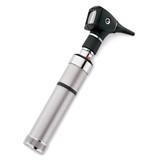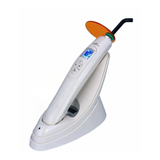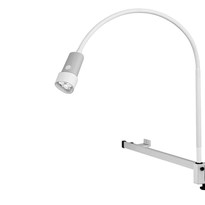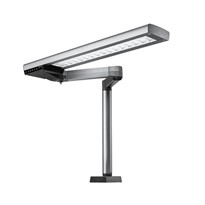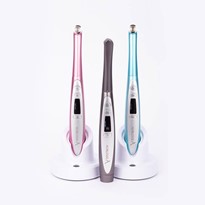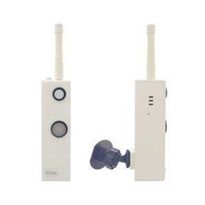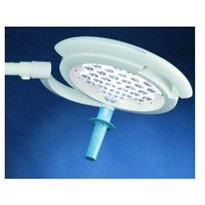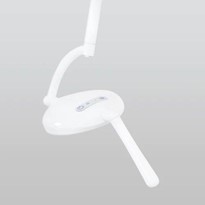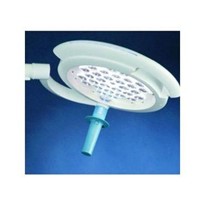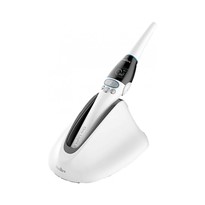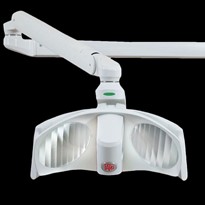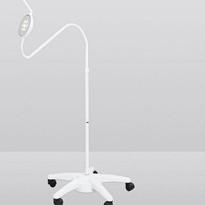Below is an explanation of the most common features associated with medical lights so you can match your requirements with the perfect lighting scenario.
Lux (lx)
Lux is used to measure the amount of light output in a given area. It enables us to measure the total ‘amount’ of visible light present and the intensity of the illumination on a surface. Lux is measured by a Luxmeter at a certain point.
Dioptre
When looking at magnifiers, such as the Derungs Opticlux Magnifying Luminaire, you will come across the term Dioptre.
A dioptre is a unit of measurement which refers to the amount of curvature a lens will have. Greater curvature means a thicker lens, more magnification, and a higher dioptre number.
Using the dioptre number to find the magnification level of a lens is quite simple:
Divide the dioptre number by 4 then add one.
For example, Derungs Opticlux Handheld Magnifying Light has a dioptre of 3.5.
3.5 ÷ 4 = 0.875 + 1 = 1.875 (rounded to 1.9).
Therefore, the Opticlux magnifier lens has a magnification of 1.9x meaning that items under the lens appear 190% bigger than normal.
Central Illuminance (Ec)
Also often referred to as Illuminance or Light Output – describes the maximum illuminance (in lux), generally at 0.5 m or 1 m distance from the light emitting surface in the light field centre (described below). Ec is therefore maximum illuminance at the light field centre.
Light Field Centre
The point in the light field (lighted area) where the illuminance reaches maximum lux intensity. This is the reference point for most measurements such as the above mentioned 60,000 lx @ 0.5 m.
Illuminance Field
Illumination Field is the area of homogenously lit surface will be described as a Diameter and a Distance from the light source. For example: 21 cm @ 0.5 m.
Consider what size Illuminance Field you require by considering what you are examining. For example, a hand requires a smaller Illuminance Field than an abdomen.
Light Field Diameter
The diameter of light field around the light field centre, ending where the illumination reaches 10% (D10) or 50% (D50) of Ec. This information guides you as to how the intensity of the light decreases as you move away from the Light Field Centre being highest lux at the Light Field Centre and lowest lux at the Light Field Diameter.
Example 1: d10 @ 0.5 m = 104 mm means that, if Ec for the light being described was 100,000 Lux and the light bulb is 0.5m above the illuminated surface, the size of the field of light containing greater than 10% of Ec (10,000 lx in this instance) is 104 mm in diameter.
Example 2: d50 @ 0.5 m = 61 mm means that , if Ec for the light being described was 100,000 Lux and the light bulb is 0.5 m above the illuminated surface, the size of the field of light containing greater than 50% of Ec (50,000 lx in this instance) is 61 mm in diameter.
Colour Temperature & Kelvin Rating
Colour Temperature is a scale that measures and describes how ‘warm’ (yellow) or ‘cool’ (blue) the light from a light source is. Colour Temperature is often categorised as Warm White, Cool White or Daylight and is measured in degrees of Kelvin (K) on a scale of 1,000 to 10,000.

Values in Kelvin
The low end of the Kelvin (K) spectrum is red, and the high end of the spectrum is blue. Right in the middle is daylight. Essentially the lower the number the ‘warmer’ or yellower the light whereas the higher the number the ‘cooler’ or bluer the light.
The whiteness of a light is particularly important in Medical Examination and Procedural lighting due to the importance of doctors, surgeons, veterinarians and other specialists being able to, very accurately, distinguish different colours in flesh and body fluids required for accurate examination, diagnosis and treatment of a range of medical conditions.
Warm & Cool Colour Temperatures, having more yellow, red, blue and green tones, can therefore alter how we see colour and inhibit accurate diagnosis.
Medical lighting therefore typically uses a Kelvin range of 5,000 K to 6,500 K with the light becoming whiter, the higher the number towards 6,500 K. It is important to note however that continuing beyond 6,500 K the appearance of the light becomes an ‘Overcast Daylight’ with the introduction of blue light.
Homogenous Light Field
Derungs Medical Lights utilise a unique LED design called Diamond Cluster Optics. This state-of-the-art LED technology, exclusive to Derungs, provides a uniform light temperature quality throughout the Light Field.
Other medical LED examination lights in the marketplace do not offer this homogeneous light field which means, although the centre of the light field may achieve the colour temperature they promote, as you work out from the centre the colour cools, emitting more yellow into the light which may have a negative impact on your ability to accurate diagnose certain medical conditions.
Colour Rendering
Colour rendering is an indication of a light sources ability to realistically reproduce the colour of an object.
Colour rendering is measured on a scale between 0 and 100. This is called the Colour Rendering Index or CRI. The lower values indicating poorer colour rendering that then higher values which is why we often refer to Colour Rendering as Accurate Colour Reproduction.

Derungs Medical Examination & Procedure Lights are consistently >95 CRI quality ensuring doctors receive Accurate Colour Matching to perform their jobs to the highest standard.
Lumens & Watts
 Lumens are ‘a unit of luminous flux in the International System of Units, that is equal to the amount of light given through a solid angle by a source of one candela intensity radiating equally in all directions.’ Basically; Lumens = Brightness
Lumens are ‘a unit of luminous flux in the International System of Units, that is equal to the amount of light given through a solid angle by a source of one candela intensity radiating equally in all directions.’ Basically; Lumens = Brightness
Watts measure energy use, not light output. With LED technology, wattage is no longer a reliable method to indicate how bright a bulb is. Instead brightness is expressed as Lumens.

Luminaire Efficiency
Not all light produced by a lamp will exit the luminaire, some will remain trapped inside and dissipate as heat. The luminaire’s physical characteristics will affect how much light will exit and how much will be directed at the work plane.
There are many methods and measures to communicate Luminaire Efficiency. Most common in lighting terminology is Lumens per Watt or Lm/W.
Lm/W is a measure of luminous efficacy, which is the light output in lumens using one watt of electricity. The higher the number, the less costly to run the lights.

As you can see from the table above, even LED light bulbs have a range of 40-200 Lm/W meaning that if luminaire efficiency is important to you, you should research to find the best quality LED, that will have the highest Lumen per Watt output.
Most medical examination lighting users will not be concerned with energy cost efficiency as the lights are only used for a few minutes at a time however it is critical to consider the amount of heat a light head generates.
Lower quality/lower cost examination lights, with poorer quality LED technology have a higher rate of heat dissipating into the light bulb surrounds and housing which heats up that housing, making the light too hot to touch, to move etc. etc.
Surgical lighting users need to take heed of the quality of the LED and luminaire head design regarding how much of the output is dissipated as heat, which is bad for temperature controlled, surgical field.
Hospital Products Australia are the leading distributor of Derungs Medical Lighting to all regions of Australia. Contact us if you would like further medical and architectural lighting information or help on specifications for your facility.









